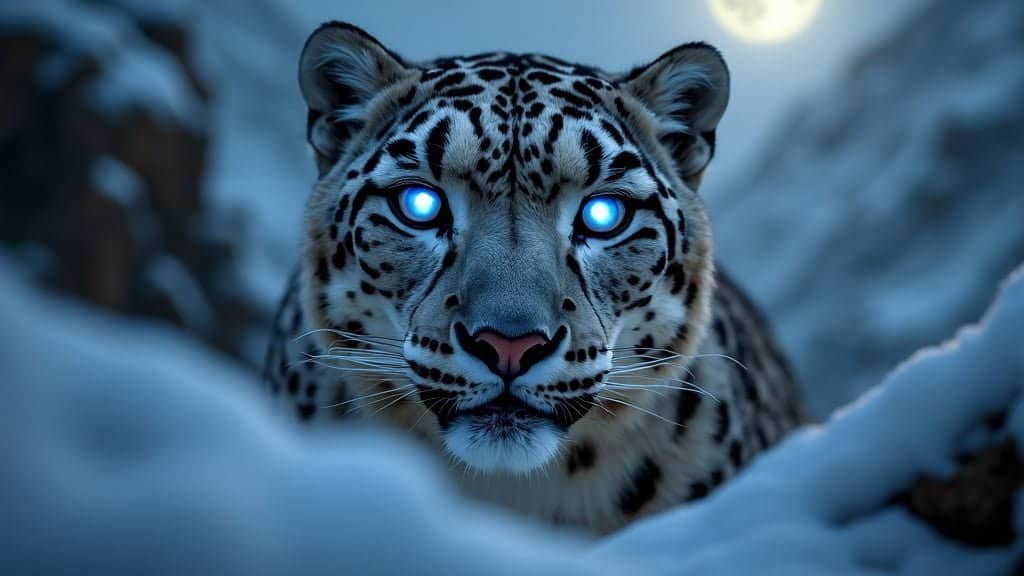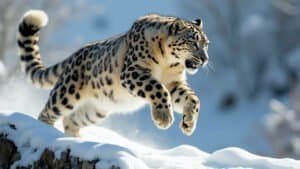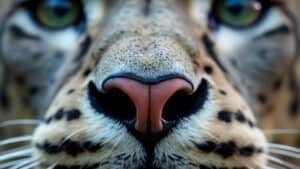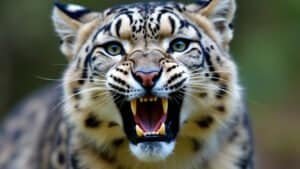Introduction
Snow leopards are majestic creatures known for their ability to thrive in harsh, mountainous terrains. One of their most remarkable adaptations is their ability to see in low-light conditions
This article will explore the specialized anatomy of the snow leopard’s eyes, including their large size, tapetum lucidum, and unique retinal structure, all of which contribute to their exceptional night vision
We will also examine the environmental factors that have shaped these adaptations and compare their vision with that of other big cats to understand how these magnificent animals have evolved to become stealthy nocturnal hunters
Snow Leopard Eye Anatomy and Night Vision
Snow leopards have evolved to survive and thrive in some of the most challenging environments on Earth. One of the key adaptations that enable them to hunt and navigate in their dimly lit, mountainous habitats is their exceptional low-light vision
This is largely due to several specialized features in their eye anatomy, which allow them to maximize the amount of light entering their eyes and enhance their ability to see in near-darkness. Understanding these adaptations provides insight into how snow leopards have become such proficient nocturnal predators
Enlarged Eye Size and Light Sensitivity
One of the most striking features of a snow leopard’s eyes is their size relative to their head. Larger eyes are a common adaptation among nocturnal and crepuscular animals, as they allow more light to enter the eye, which is crucial for vision in low-light conditions
The snow leopard’s large eyes have a wide aperture, or pupil, which can expand significantly to capture more light. This is particularly important in the dimly lit environments of the snow leopard’s high-altitude habitats, where daylight hours are often short and snow cover can reflect and scatter light, making visibility challenging
Moreover, the increased eye size directly correlates with the amount of light that can be focused onto the retina. This not only enhances the snow leopard’s ability to detect movement at dusk or dawn but also allows them to discern finer details in their prey and surroundings, which is vital for successful hunting
Tapetum Lucidum: Enhancing Night Vision
A critical component of the snow leopard’s eye that enhances its night vision is the tapetum lucidum. This structure is a layer of tissue located behind the retina that reflects light back through the retina, giving photoreceptor cells a second chance to absorb it
In low-light conditions, this reflection effectively amplifies the amount of light available to the retina, improving the animal’s vision in the dark
The tapetum lucidum is also responsible for the characteristic eye shine seen in many animals when caught in a beam of light at night. In snow leopards, this feature is particularly well-developed, contributing significantly to their ability to hunt at night or during the twilight hours. This adaptation is especially important in their mountainous habitats, where they often encounter prey in dim light conditions
The enhanced sensitivity provided by the tapetum lucidum allows snow leopards to detect even the slightest movements of their prey, making them formidable nocturnal hunters
Pupillary Response to Low Light
The pupils of snow leopards are highly adaptive, capable of changing size rapidly to regulate the amount of light entering the eye. In bright light, their pupils constrict to limit light intake and protect the sensitive retinal cells from damage. In contrast, in low-light conditions, their pupils dilate to allow as much light as possible to enter
This rapid response to varying light conditions is crucial for the snow leopard’s survival. In their natural habitat, light levels can change quickly due to the mountainous terrain, where shadows can cast sudden darkness, and reflections from snow can cause glare
The snow leopard’s pupils must adjust quickly to these changes to maintain optimal vision, whether they are hunting or navigating their rugged environment. This adaptability in pupil size is one of the reasons why snow leopards can move so confidently and hunt so effectively in the twilight or at night, when other animals might struggle to see
Retinal Adaptations in Snow Leopards
The snow leopard’s remarkable ability to see in low-light environments is further enhanced by specific adaptations in their retinas. The retina, a light-sensitive layer at the back of the eye, plays a crucial role in converting light into electrical signals that the brain interprets as visual images
In snow leopards, the retina has evolved to optimize vision in dim conditions, allowing these elusive predators to detect prey even in near darkness
Rod Cells vs. Cone Cells: A Balance for Night Vision
The retina contains two main types of photoreceptor cells: rod cells and cone cells. Rod cells are highly sensitive to light and are primarily responsible for vision in low-light conditions, while cone cells are responsible for color vision and function best in bright light
In snow leopards, the retina is densely packed with rod cells, giving them a significant advantage in low-light environments
The high concentration of rod cells in the snow leopard’s retina means that their eyes are particularly adept at detecting movement and shapes in dim light, which is crucial for spotting prey
Although this comes at the expense of color vision, which is less developed in snow leopards compared to animals with more cone cells, it’s a worthwhile trade-off for a nocturnal predator. The balance between rod and cone cells in snow leopards is a prime example of how their visual system has adapted to the demands of their environment
Photoreceptor Distribution
The distribution of photoreceptor cells across the retina is another critical factor in the snow leopard’s ability to see in low light. In snow leopards, the density of rod cells is highest in the central region of the retina, which is responsible for the most acute vision. This allows them to focus on and track moving objects even in the dark, a crucial skill for hunting
This dense concentration of rod cells in the central retina, coupled with the wide field of view provided by their large eyes, ensures that snow leopards can detect the slightest movements of their prey, even in the dim light of dawn or dusk
The peripheral areas of the retina, while less densely packed with photoreceptors, still contribute to a broad visual field, enabling snow leopards to be aware of their surroundings and detect potential threats or opportunities from a distance
Retina’s Role in Low-Light Conditions
In addition to the high concentration of rod cells, the snow leopard’s retina also features specialized adaptations that enhance its sensitivity to low light
The retinal pigment epithelium, a layer of cells that nourishes the retina and absorbs excess light, is adapted to minimize light scattering within the eye. This ensures that light is efficiently focused on the photoreceptor cells, maximizing the snow leopard’s ability to see in dim conditions
Furthermore, the retina’s ability to quickly adjust to changes in light intensity is crucial for the snow leopard’s survival. In the mountainous regions where they live, snow leopards often move between brightly lit, snow-covered areas and shadowy, rocky outcrops
The rapid adaptation of their retina to these changing light conditions allows them to maintain clear vision at all times, whether they are stalking prey or navigating their rugged environment
Environmental Influences on Vision
The snow leopard’s visual adaptations are not just a result of its anatomical features, but also a response to the specific environmental challenges of its natural habitat. Living in the rugged, high-altitude regions of Central and South Asia, snow leopards face a unique set of conditions that have shaped their ability to see and hunt in low light
These environmental factors play a crucial role in the evolution of the snow leopard’s vision, ensuring that these solitary predators are well-equipped to thrive in their harsh surroundings
Mountainous Terrain and Low-Light Adaptations
The snow leopard’s habitat consists primarily of steep, rocky mountains, often covered in snow, where the availability of light can vary dramatically
These regions are characterized by long winters with short daylight hours and frequent twilight conditions, creating an environment where low-light vision is essential for survival. The snow leopard’s eyes have evolved to maximize light intake, allowing them to navigate and hunt effectively in this challenging environment
The high altitudes at which snow leopards live also contribute to their need for specialized vision. At these elevations, the atmosphere is thinner, and the sunlight is more intense during the day but fades quickly in the early morning and late evening. The ability to see in low light gives snow leopards a significant advantage, as they are often most active during dawn and dusk, times when their prey is also on the move
This crepuscular activity pattern is a direct response to the environmental conditions of their habitat, where the snow leopard’s superior night vision allows it to spot and stalk prey with minimal competition from other predators
Snow Leopard’s Hunting Techniques
The snow leopard’s hunting strategy is closely tied to its vision. These big cats are ambush predators, relying on stealth and surprise to capture their prey. Their ability to see in low light is crucial for this hunting technique, as it allows them to spot potential prey from a distance and approach undetected under the cover of darkness or dim light
In the snow leopard’s natural environment, prey animals such as ibex and blue sheep are often found on steep, rocky slopes, where the terrain provides ample hiding spots but also presents challenges in terms of visibility
The snow leopard’s enhanced low-light vision allows it to detect subtle movements and identify prey even in the shadows of rocky outcrops or in the low-contrast environment of snow-covered landscapes. This visual advantage, combined with their silent and cautious approach, makes snow leopards highly effective hunters, capable of taking down prey much larger than themselves
Eye Color and Vision Clarity
The eye color of snow leopards, typically a pale green or gray, is not just a distinctive physical trait but may also play a role in their vision. While the exact impact of eye color on vision is still a subject of scientific research, it is believed that lighter eye colors may help reduce glare from snow and bright sunlight, improving the snow leopard’s ability to see in their reflective environment
In snowy landscapes, where light is often scattered and reflected, reducing glare is crucial for maintaining clear vision. The lighter pigmentation in the snow leopard’s eyes could contribute to better visual clarity in these conditions, allowing them to focus more effectively on their surroundings and potential prey
This adaptation, combined with their overall visual acuity, ensures that snow leopards can maintain sharp vision even in the most challenging environmental conditions
Comparison with Other Big Cats
Snow leopards share the Felidae family with other big cats like lions, tigers, and jaguars. While all these predators have evolved to be effective hunters in their respective environments, the visual adaptations of snow leopards are particularly specialized due to the unique challenges of their high-altitude habitats
Comparing the vision of snow leopards with that of other big cats highlights the distinctive features that set them apart and the evolutionary paths that have shaped their ability to thrive in low-light conditions
How Snow Leopards’ Vision Compares with Lions
Lions, primarily inhabitants of the African savannah, rely on their vision for hunting in different light conditions, much like snow leopards
However, lions typically hunt in the open plains where light is more abundant, even at night. Lions also benefit from a social structure that allows them to hunt in groups, which can compensate for any individual shortcomings in vision
In contrast, snow leopards are solitary hunters in much more rugged terrain with less predictable lighting. While both species have a tapetum lucidum to enhance night vision, snow leopards have a higher proportion of rod cells in their retinas, providing superior sensitivity to low light compared to lions
This difference in retinal composition underscores the snow leopard’s adaptation to an environment where every ounce of light is precious, and their solitary nature requires them to rely solely on their visual acuity without the support of a pride
Vision Differences with Tigers and Jaguars
Tigers and jaguars, like snow leopards, are also solitary hunters, but they inhabit very different environments. Tigers are found in dense forests and grasslands, while jaguars roam the tropical rainforests and wetlands of the Americas. Both of these environments present challenges that have influenced the visual adaptations of these big cats
Tigers, for instance, have developed vision that allows them to detect movement through dense vegetation and in dappled light. Their eyes are adapted to focus on prey in the shaded underbrush, with a balance of rod and cone cells that supports both night vision and color differentiation
However, in comparison, the snow leopard’s eye is more specialized for extreme low-light conditions, with a higher concentration of rod cells to maximize light sensitivity in the often dim environments of their mountainous homes
Jaguars, on the other hand, face the challenge of hunting in environments where light can be limited by dense canopy cover. Like snow leopards, they possess a high density of rod cells for night hunting, but their tapetum lucidum is not as pronounced, as they do not face the same extreme low-light conditions
The snow leopard’s visual system is more attuned to capturing the faintest light, which is a necessity in the open, high-altitude landscapes they call home
Evolutionary Pathways of Big Cats’ Eyes
The evolutionary pathways that have led to the current visual adaptations of snow leopards, lions, tigers, and jaguars reveal much about how each species has optimized its vision for survival in different environments. While all these big cats have a common ancestor, their visual systems have diverged significantly to meet the demands of their respective habitats
Snow leopards represent an extreme example of adaptation to low-light vision, a necessity for surviving in the dim, snowy landscapes of Central Asia
Over generations, natural selection has favored snow leopards with better night vision, enabling them to detect and hunt prey in conditions that would challenge other big cats. This evolutionary path highlights the snow leopard’s specialization as a nocturnal hunter, in contrast to the more versatile but less specialized vision of lions, tigers, and jaguars
This comparison illustrates how the visual systems of big cats are not one-size-fits-all but are instead finely tuned to the specific challenges of their environments. The snow leopard’s eyes, with their unique adaptations, are a testament to the power of evolution in shaping creatures to excel in their natural habitats, even under the most challenging conditions
Conclusion
The snow leopard’s ability to thrive in some of the harshest environments on Earth is a testament to its remarkable adaptations, particularly in its vision. From the large, light-sensitive eyes to the high concentration of rod cells in the retina and the specialized tapetum lucidum, every aspect of the snow leopard’s eye is fine-tuned for optimal performance in low-light conditions
These adaptations allow snow leopards to navigate and hunt effectively in the dim, mountainous terrains they call home. When compared to other big cats, it’s clear that the snow leopard’s visual system is uniquely suited to its solitary and nocturnal lifestyle, shaped by the specific environmental challenges it faces
These specialized adaptations not only ensure the snow leopard’s survival but also highlight the incredible diversity in the evolutionary pathways of big cats













